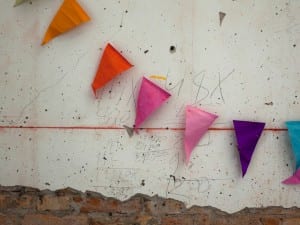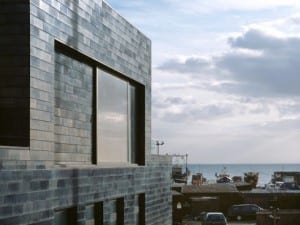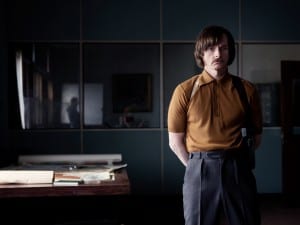Peter Kardia was instrumental in his experimental teaching methodologies of the 1960s. In the show, From Floor to Sky at Ambika P3, 28 artists show their work juxtaposed from the past to the present.
England during the 1960s and 1970s was a tumultuous, exciting and, without a doubt, revolutionary period of modern history: the Cold War, Vietnam, the Apollo 11 mission with Neil Armstrong walking on the moon, the Beatles splitting up, and the Watergate Nixon scandal are but a few major events that defined those decades. Art, as a creative method of expression, was vital to those rebelling against the traditional political and social systems. It was used as a tool to articulate the discontent and dissatisfaction felt by much of mainstream society after the previous four decades of austerity and strife. The pedagogy of art schools, specifically St. Martins School of Art and the Royal College of Art in London, changed dramatically during this time. There was an abrupt and decisive break away from modernism and its emphasis on the individual arts and how each medium was applied within them. Teacher’s, such as Peter Kardia, were instrumental in the development of this new pedagogy, which in Kardia’s words: “Focused on developing in students a genuine engagement with their creative process” rather than on the finished piece of art. Unconventional though some of the projects and tasks set to the students were, they did inflame the creative process and force the students to think outside the box.
This March, From Floor to Sky, a comprehensive exhibition of contemporary British sculpture, opens at Ambika P3 in London. The exhibition, curated by Kardia, looks at the history of contemporary British sculpture as a reflection of the teaching methods and programmes offered in London during the 1960s and 1970s. Kardia, who taught at St. Martin’s and the Royal College of Art, has asked 28 artists to contribute two pieces of their work: one example from their current oeuvre and one example from their time as students at the colleges. The resultant exhibition offers a brief, but succinct glimpse, into the creative development of artists from their time as students to the present day.
The development of these young burgeoning art students into established, successful artists had as much to do with their innate talent as with the innovative and radical teaching methods of tutors like Kardia. Teaching experiments, such as that of the “Locked Room” at St. Martin’s in 1969, obliged students to move past the delimiting rules of conventional sculpture and art history that had been battered into them for years. The experiment, which lasted a term and was conceived of by Kardia, Peter Harvey, Garth Evans and Gareth Jones, consisted of placing students into a locked studio from 10am – 4pm, with scheduled breaks. They were given the materials with which to work but were allowed to bring in their own tools, though not new or additional material. When the tutors deemed the works done, whether it had been four weeks or four days, the “finished” pieces were removed and the next day the students would arrive to find an entirely new material with which to begin working with. Choice was taken out of their hands and by doing that Kardia, as well as Harvey, Evans and Jones, compelled the students to step out of their comfort zone – to play with the material and the process of creation in a temporally, and spatially, confined space. There was an almost panoptic quality to the experiment in that they were watched and observed by each other, forbidden from socially engaging with one another, and all unaware of the final outcome and impetus behind the project. The unfamiliar qualities of the material and of the task, that being to create a work of art, forced the students to experiment with their own preconceived notions of fine art and sculpture. As Louisa Buck states, in reference to the work of Richard Wentworth, but which can be applied quite easily to the impetus behind the pedagogy of Kardia: “If Wentworth gives one message to his audience, it is this; keep looking, keep wondering, and consider all options.”
The artistic process became of paramount importance; a process defined by art historian and critic Kristine Stiles as, “a point of intersection and transit between traditional painting and sculpture and the profusion of experimental practices that occurred in the late 1960s, which collapsed form and content into a continuous state.” The emphasis on this idea of “process” in the pedagogy of the Royal College of Art and St. Martin’s can be seen reflected in the works of many of the artists chosen for From Floor to Sky. Artists such as Hamish Fulton, whose long walks in the countryside document, through the physical movement of his body through space, the landscape. The piece of art is the progression of his body unto and within the physical environment and, analogous to the sculptor’s hands that alter a piece of marble, so do his feet alter the earth. The resultant photographs and paraphernalia, which visually document this alteration and appropriation of the physical site, are akin to a marble sculpture. Fulton, like Richard Long and Roger Ackling, who both also studied at St. Martin’s during the 1960s, focused on art outside of the studio: at the ability of their bodies to physically alter the surrounding landscapes, thereby emphasizing the impact our environments have upon us and vice versa.
The exhibition strives to illustrate the innate problems that arise when attempting to teach art, as it is difficult to grade a piece of art by a set list of criteria. Kardia states: “Any person teaching in art colleges always has to face up to the requirement that in some way the educational process being carried out has to be validated. Finished objects tend to be the easiest and most convenient way in which this can be done”, hence the historical emphasis on the final art work in art schools. However, the creative process is as important as the finished object and it is this value that Kardia tried to impart upon his students during this period.
The willingness of both the students and the teachers, to experiment must not be underestimated; the artists selected for the exhibition have, and are willing to break down preconceived precepts of art and technique, in a way that Kardia feels contemporary art students miss out on. He argues that: “Students do not appear to be give time to develop a passionate belief in the priority of art and seem willing to allow what they produce to exist at the same level as advertising and fashion.” Perhaps this is just indicative of the disappearance of the lines separating “high” and “low” art: lines famously broken down by Andy Warhol, Jeff Koons, and Damien Hirst. The priority of art is intrinsically tied in with the act of making, of physical production, and thus begins with the germ of an idea. The preliminary idea must then be expanded into a concept which can result in a final piece of art. With hindsight this act of making seems quite clear, but for artists it is never as clear-cut or simplistic as it appears. From Floor to Sky juxtaposes the selected artists’ early works with newer pieces in a chronological order to illustrate how each artist has developed in this process of creating art.
Other than the fact that the artists selected were all previously students of Kardia, there is a common thematic strand as well: each artist pushes the artistic and theoretical boundaries of art historical discourse and practice in a very much Duchampian way. As Marcel Duchamp appropriated everyday objects so do many of the artists in this exhibition; some, such as Richard Wentworth, appropriate mundane, functional objects and incorporate them into their works, whilst others, such as John Hilliard and Nina Danino, use them as a source of inspiration and instead apply digital means (whether it be a photograph or video) to document the often ephemeral nature of their work. Duchamp infamously shattered the historical idea of what constituted a piece of art, and these artists continue in that tradition, pushing against historically fixed ideas and standards of art.
From Floor to Sky ran from 5 March – 4 April 2010, at Ambika P3 in London. www.p3exhibitions.com.
Niamh Coghlan





